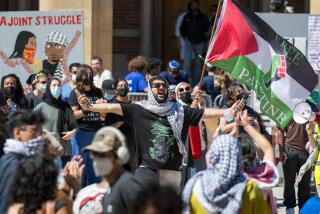Beijing Students Win Concession : Chinese Officials Agree to Talks; Marchers Sweep Past Police Lines
- Share via
BEIJING — In a dramatic concession to pro-democracy students, the Chinese government announced late Thursday that it is prepared to open a dialogue with student leaders to discuss their demands.
The announcement came after tens of thousands of student demonstrators marched through Beijing for more than 12 hours, sweeping past police lines and returning triumphantly to their campuses.
Communist Party authorities had warned that they would crush the march. Instead, China’s leaders suffered the humiliation of a surprisingly strong public rebuke from the elite youth of the nation, supported by hundreds of thousands of cheering Beijing residents.
The students are demanding freedom of the press, better treatment of intellectuals and an attack on corruption.
Conditions Attached
Although the government’s agreement to meet with student leaders seemed to be a significant concession, it contained conditions that could prove unacceptable to the protesters.
The official New China News Agency reported that the State Council, China’s Cabinet, “had entrusted the All-China and Beijing Municipal students’ federations to forward the students’ demands and sponsor talks with the appropriate authorities.”
This appeared to mean that protest leaders could meet with government officials but that arrangements must be made through the official Communist Party-controlled student associations, which the demonstrators have rejected in recent days.
A procession of about 50,000 banner-waving students from dozens of Beijing universities took part in Thursday’s march. Accompanied by a roughly equal number of non-student supporters, they broke through a series of police lines along Beijing’s main boulevard in the afternoon and swarmed past the great gate to the Forbidden City that fronts on the north end of Tian An Men Square.
Police Get a ‘Thank You’
At each line, the police yielded without violence, and the orderly and highly disciplined crowd chanted, “Thank you, policemen.”
It was shortly before 5 p.m. when the crowd reached Tian An Men, trapping 16 truckloads of unarmed soldiers who had been circling the square in an attempt to frighten the advancing procession into halting. After some initially tense moments, it became clear that the soldiers intended to stay on the open-backed trucks. The crowd eventually made way for them to drive away.
Then thousands of supporters of the students ran onto the square, which until then had been sealed off by the police.
But the three-mile-long student procession, rather than occupying the square, continued to the east through the main part of the city.
Some youthful policemen, standing in groups along the side of the road after abandoning efforts to control the situation, returned the waves and smiles of many in the crowd. A few even raised their hands with two fingers extended, returning the V-for-victory sign made by some in the crowd.
The students maintained order throughout the march, with parade marshals linking hands at the sides of the column. The students eventually turned onto the three northbound lanes of a major highway, and thousands of onlookers, many of them applauding or cheering, gathered on overpasses to watch them head triumphantly back to their campuses.
“Physically we’ve pushed it as far as we can,” a Beijing University history graduate said to a correspondent for Reuters news agency toward the end of the 20-mile march. “We’ve won the day. For the government to say it will grant dialogue is a major concession.
“We’ve shown the government that peaceful, patriotic demonstrations are possible.”
The government had attempted to intimidate the students with a harsh editorial published in official newspapers Wednesday.
The editorial was read on national television Tuesday, and rebroadcast that evening over campus loudspeakers, and it was discussed Wednesday at meetings of grass-roots-level Communist Party leaders. It charged that students were seeking to overthrow the Communist Party and declared that the nation faced “a grave political struggle” against this challenge.
The editorial appeared to have backfired, at least to the extent that it inflamed student passions rather than cowing them into silence.
The marching students chanted rhymes ridiculing the official news media, and, judging from the cheers, these proved to be popular with onlookers along the 20-mile protest route. One went like this:
“Renmin Ribao qipian renmin; Guangming Ribao meiyou guangming; Beijing Ribao hushuo badao; Beijing Diantai diandao heibai.” (“People’s Daily deceives the people; Guangming (Brightness) Daily has no brightness; Beijing Daily talks nonsense; Beijing Broadcasting confuses black and white.”)
Most of the banners and chants emphasized themes of democracy, freedom, science and education. But in an apparent act of political self-defense, the students also carried, for the first time, many banners declaring, “Long Live the Communist Party.”
Students emphasized that they do not seek to overthrow the party but wish rather to make China’s system more democratic and less corrupt.
“Patriotism is not a crime,” the marchers chanted.
As they marched back to campuses, it was obvious that the exhausted but exhilarated students considered the government announcement of its willingness to talk--and the entire day’s events--to be a clear victory.
And they were sure they had written history.
“Nothing like this,” one student said as he walked along, “has ever happened before.”
More to Read
Sign up for Essential California
The most important California stories and recommendations in your inbox every morning.
You may occasionally receive promotional content from the Los Angeles Times.













